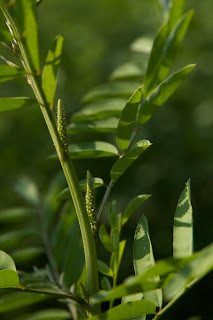Today, I was greeted by a lot more blooms.
Because the direct dye experiment was so successful, I decided to use that method to try and make indigo extract. I used the direct dye method up to a certain point. Let me explain.
I cut 8 ounces of leaves.
Put the leaves in the jar and covered with water then put the jar in a water bath, just like before.
I kept very detailed records of this, but I won't bore you with all of that.
Basically I heated them, strained the liquid from the leaves and put the liquid back in the jar and aerated it with the immersion blender. I didn't take pictures of that, it was just like before.
At the point where I would add ammonia and Spectralite to reduce it, instead, I added a little lime and continued with the aeration until it looked like this.
I've covered the jar and will let it sit overnight, hoping the indigo will precipitate out and fall to the bottom of the jar. In the morning I will either have a wonderful "mud" of dark blue indigo pigment at the the bottom of the jar or it will be a big bust!
If it's a big bust, then back to the drawing board. If it's successful then I'll do another batch with a larger quantity of leaves. Say a prayer and keep your fingers crossed that I have blue "mud".
A big thank you to Casey Price for her invaluable help and moral support today!

















































